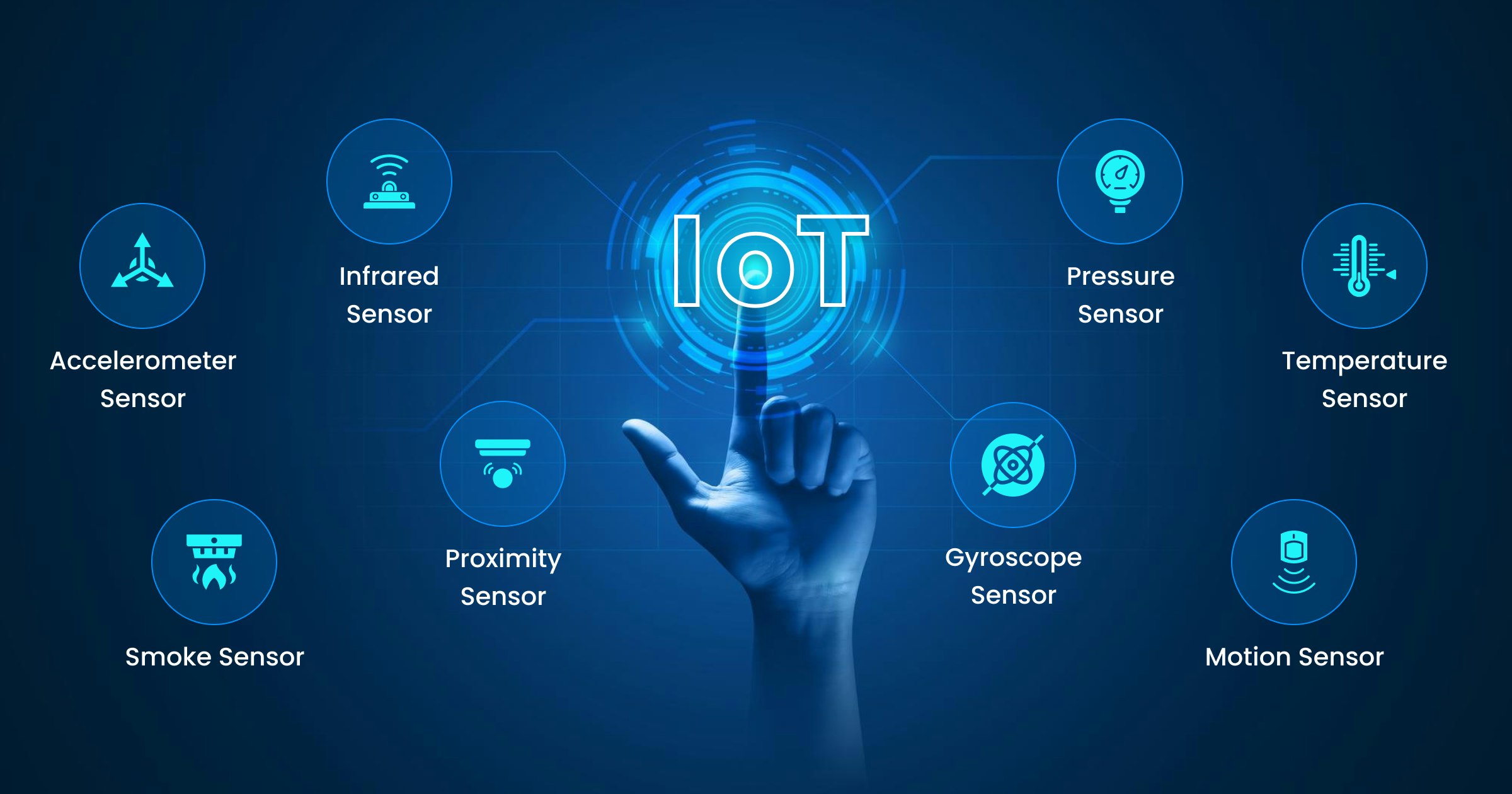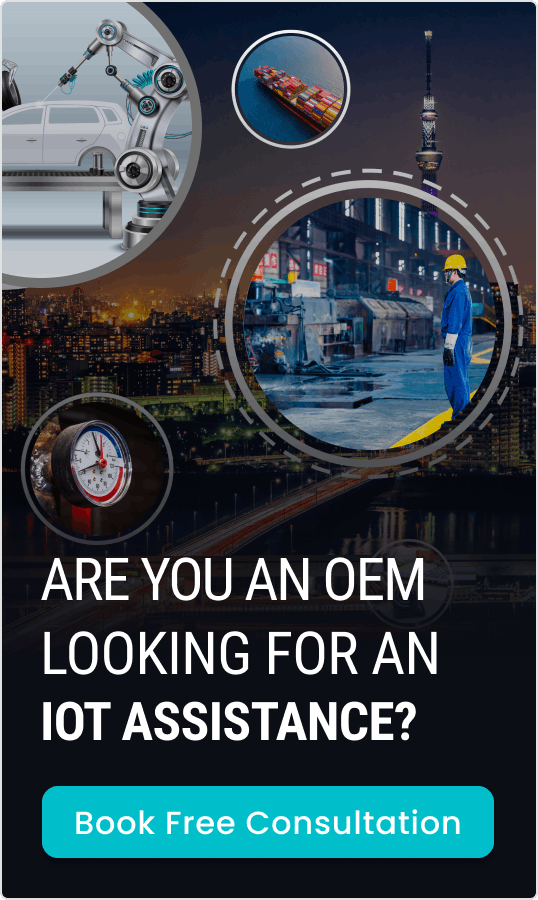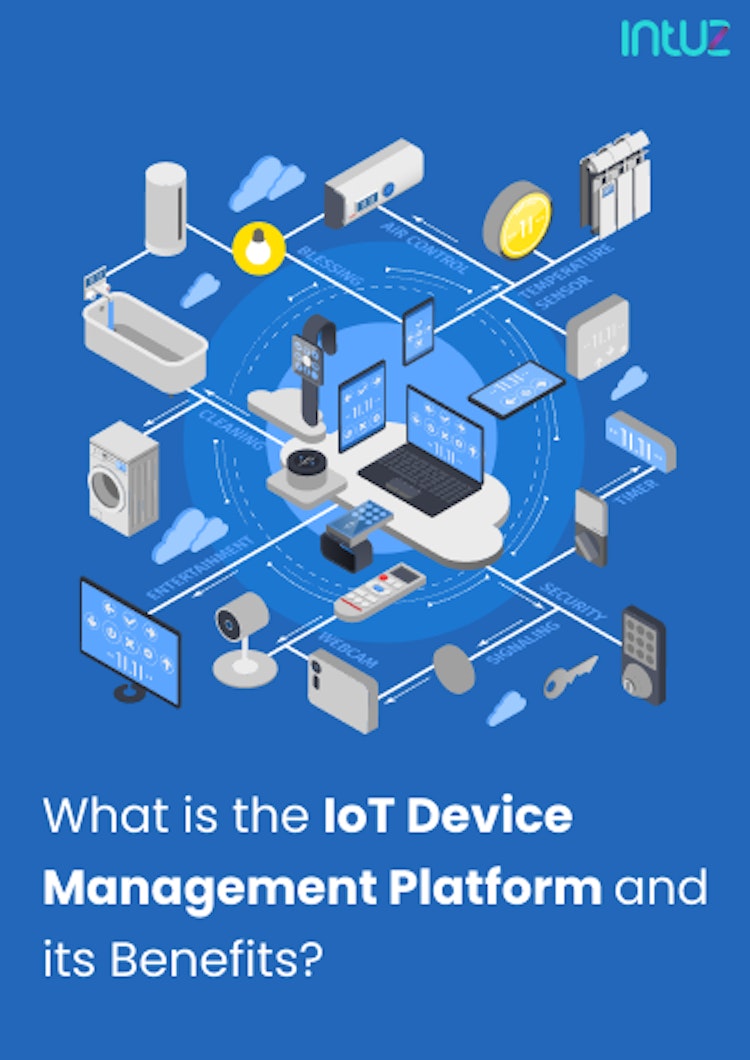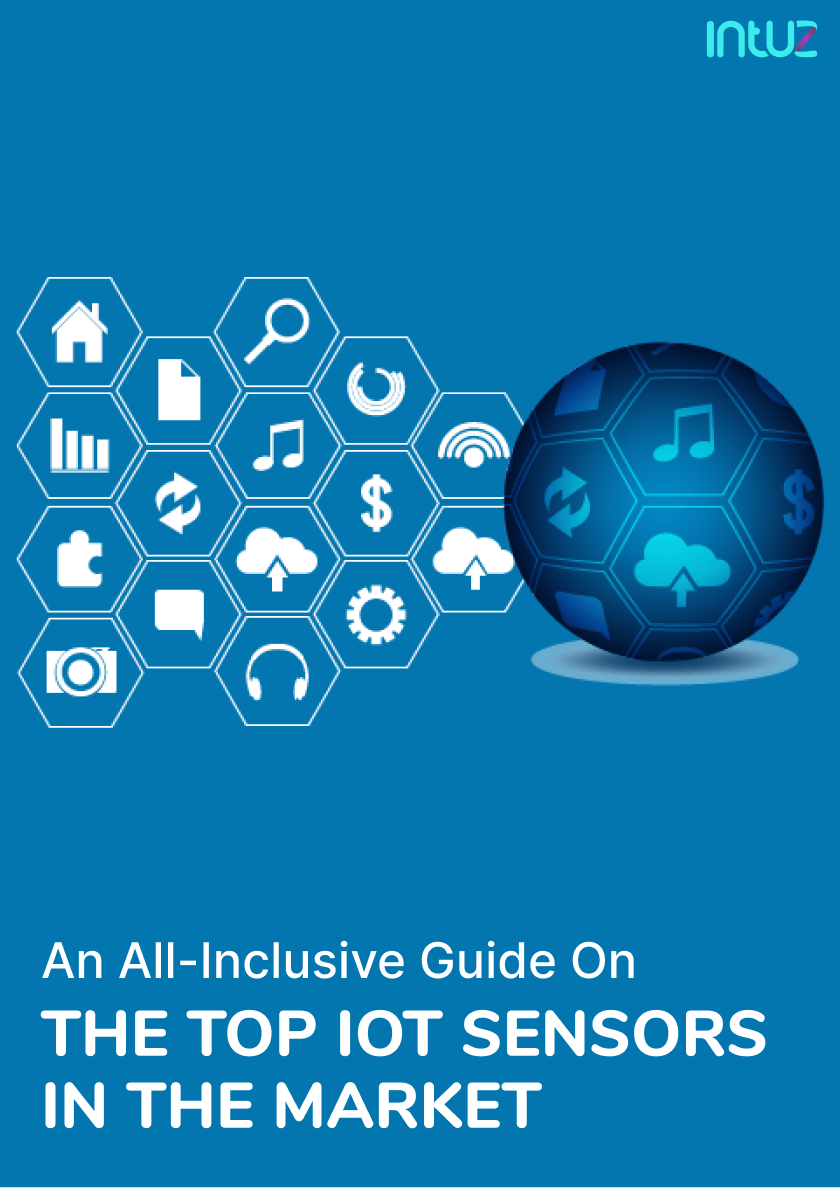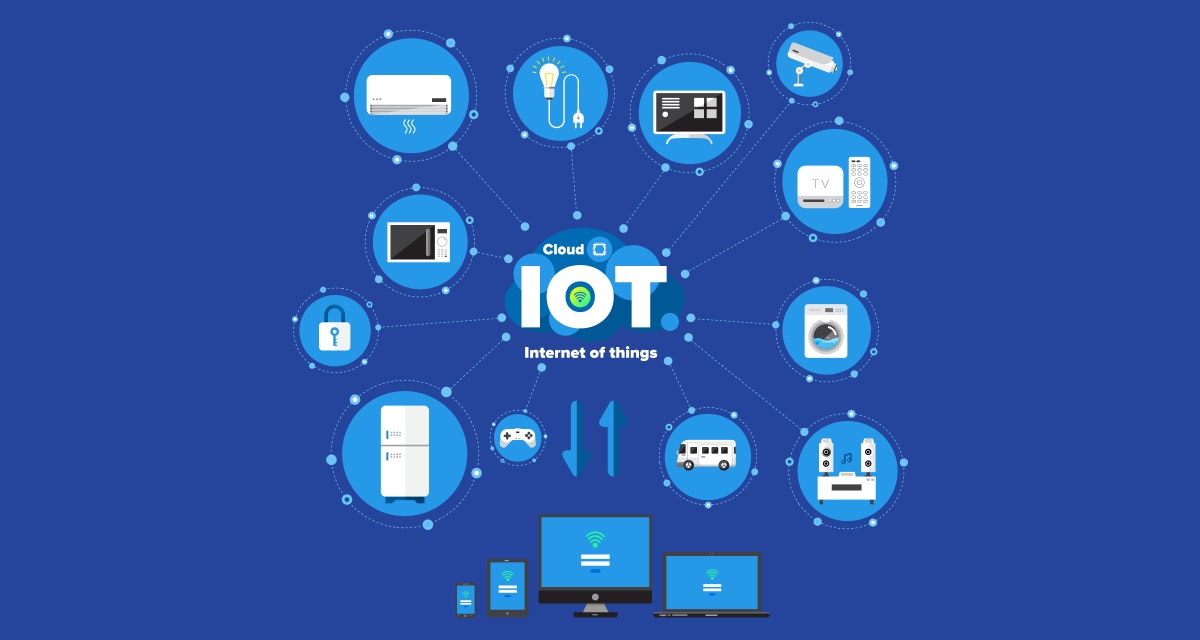We are living in a day and age when the Internet of Things (IoTs) consistently showcase their prowess to change the way businesses operate and systems function.
IoT is a giant leap in the ecosystem of Big Data, and it is indeed amazing to see how massive amounts of data can be collected, analyzed, and reported on — without any human intervention or involvement.
But do you know how IoT devices transmit data from the physical world for digital processing and enable end users to use data in conjunction with AI to make intelligent decisions? That happens with the use of sensors, of course.
Table of content
What are IoT sensors?
By definition, an IoT sensor is a connected device responsible for capturing real-time data and translating and formatting it in such a way that the data is comprehensible by other instruments. If we talk about the sensor’s nature, it is receptive to external stimuli — for example, temperature.
IoT sensors: The backbone of IoT solutions
Contrary to popular belief, the concept of IoT sensors is not new. Historically speaking, we have developed similar technologies for the very purpose of collecting and converting analog data into digital data assets. It is interesting, right?
Radar, for instance, generates and transmits radio waves, listening for reflections, which are directed to an electronic equipment for processing, if detected. Interestingly, the word “radar” is short for radio direction and ranging.
In a nutshell, Internet of Things innovation has made it possible to connect everyday things to the internet. From houses and office buildings to manufacturing units and cities — all seem to be using the IoT technology to mine and analyze data for different purposes.
Dynamic and Secure Firmware Development Services
Explore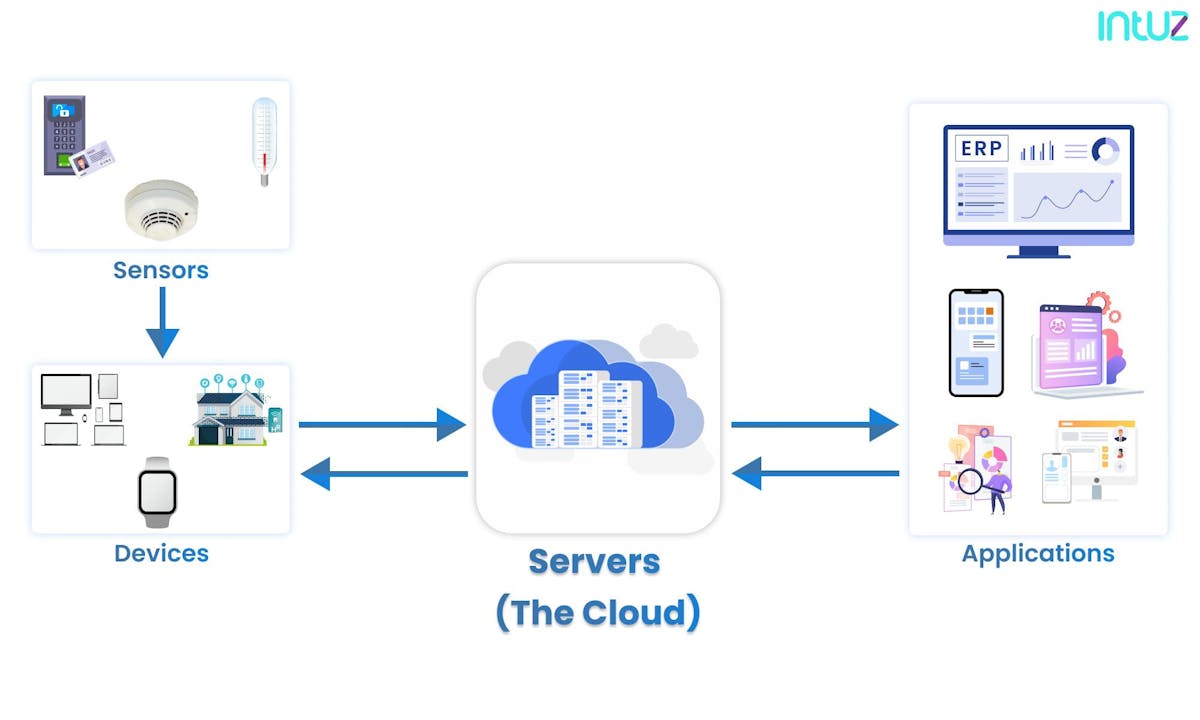
So, what benefits do IoT sensors bring to the table? Let us find out:
For starters, they are used to collect data in various industry niches such as nursing care, logistics and supply chain management , tourism and disaster prevention.
IoT sensors ingest massive data sets (clocking in hundreds of GBs of data per system) on a continuous basis without humans having to do anything.
They analyze and validate the accuracy of data being sent to the system. For instance, if a Jet engine stops on a plane, the IoT sensors will immediately send a signal to the parent host so that the necessary action can be taken.
Lastly, IoT sensors can work despite extremely low-latency access to data. Are you intrigued to know more about them? You will enjoy the next section of the guide.
Top 22 types of IoT sensors
There is no doubt that “data is the new oil,” and IoT sensors offer the perfect way to mine it and use it to our advantage. The next question is how many types of sensors are in use as of today? Are there any famous examples of their use? Let us find out:
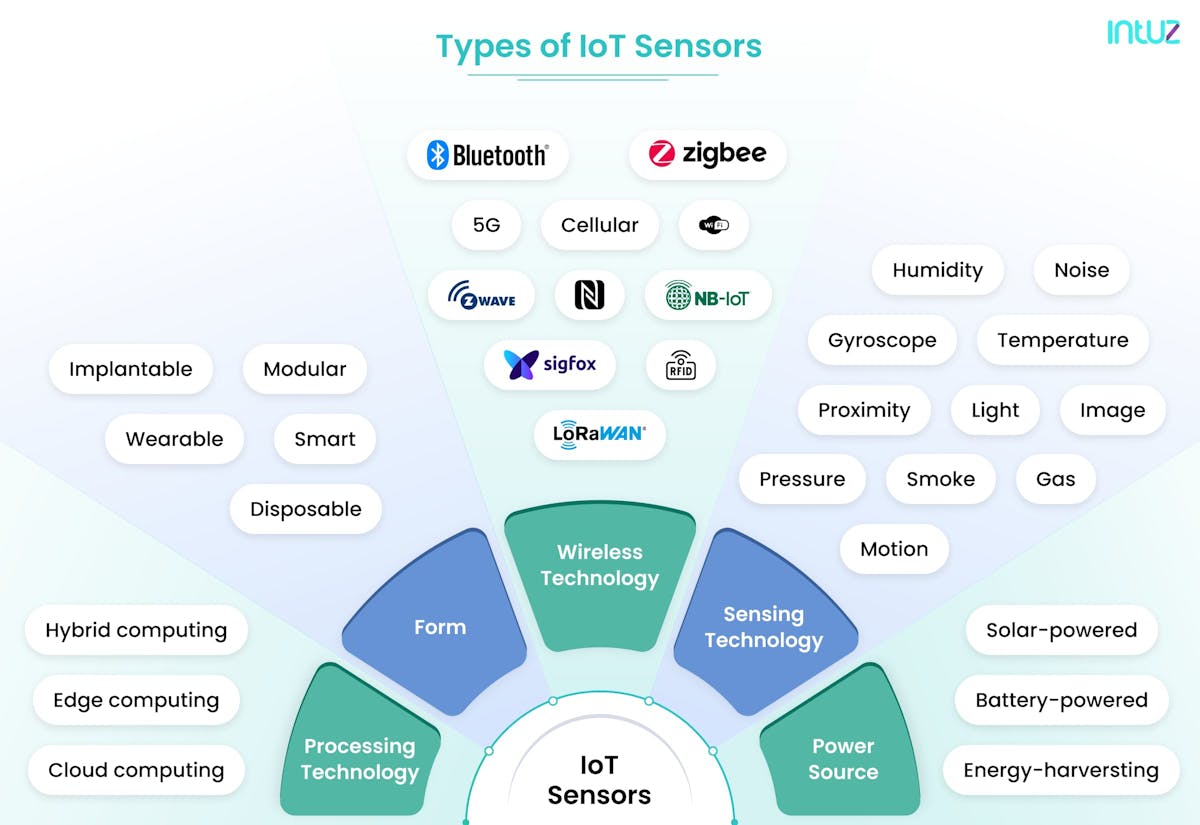
1. Temperature sensors
Think temperature sensors, and it is not hard to think of refrigerators, air conditioners and similar devices. With the advent of the Internet of things, such sensors have found a place in different industries. In fact, they are considered the most basic sensor in the ecosystem.
Features
- Temperature sensors measure the heat energy in a source, and detect and convert temperature changes into comprehensible data.
- Machinery in manufacturing, for instance, is required to be a specific temperature. Similarly in agriculture, maintaining proper temperature is key to crop growth.
Following are five sub-categories of temperature sensors:
- Thermocouples are devices that measure temperatures by keeping track of a change in voltage. As the device temperature rises, the output voltage of the thermocouple also goes up.
- Resistance Temperature Detectors (RTDs) are instruments used for measuring the device temperature on the basis of a change in resistance. For instance, if the resistance of a metal device happens in a positive direction, that means the temperature is up. Most common RTDs are wire-wound, thin-filmed and coiled.
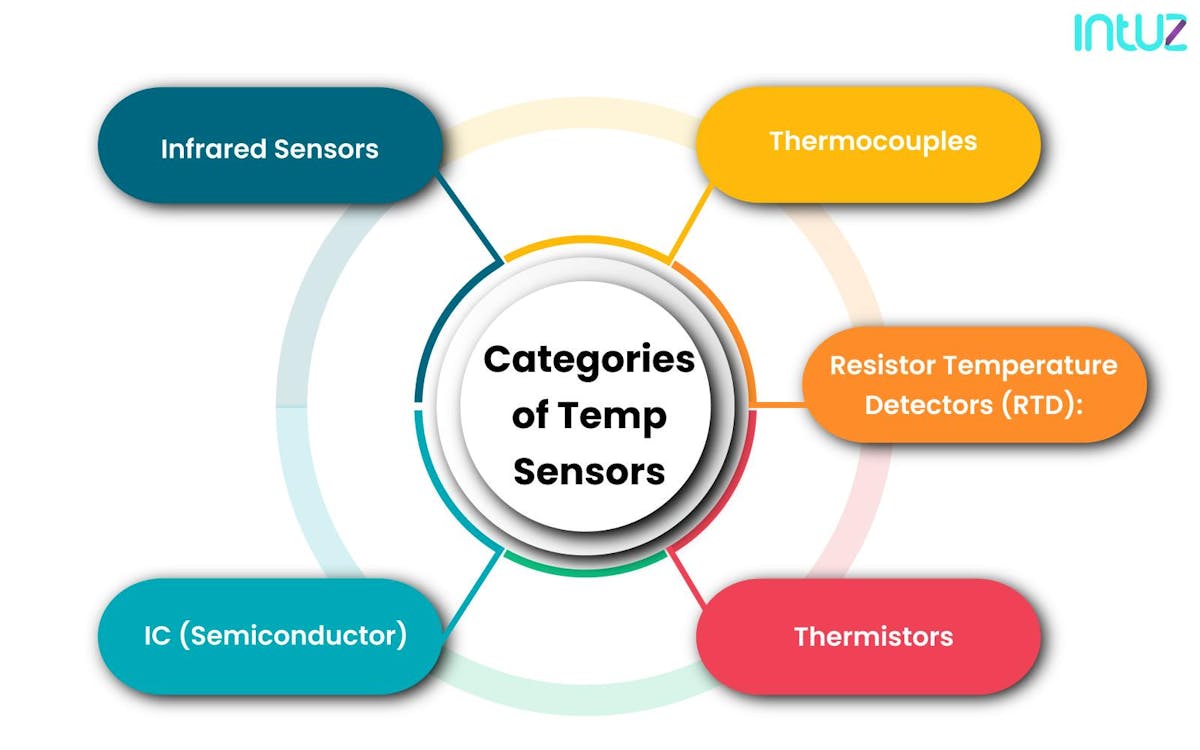
- A combination of the words “THERM-ally sensitive res-ISTOR,” thermistors change their physical resistance when exposed to temperature changes. They are usually made of ceramics (oxides of cobalt, nickel and manganese). Thermistors respond very quickly to any changes in temperatures — repeatability and accuracy.
- An Integrated Circuit (Semiconductor) is a tiny chip which can function as an oscillator, microprocessor, amplifier, and even for storing computer memory. The logic of such devices is simple. The conductivity of the semiconductor increases linearly. An IC can offer a direct temperature reading in a digital form, especially at low temperatures.
- Infrared sensors detect temperature by sensing certain characteristics of its surroundings. It either emits or detects infrared radiation. Infrared sensors are also capable of measuring the heat being emitted by an object and detecting motion. They are capable of detecting motion and measuring the heat emitted by an object.
Use cases
From electric power generation and furnace monitoring and control to aircraft engines and food and beverage processing, temperature sensors are used in various applications. These sensors are widely used in electronic thermometers. Infrared sensors typically work best with solids and liquids. They are not used on gases because of their transparent nature.
2. Proximity sensors
Commonly used in many IoT apps, proximity sensors are used for detecting the presence of nearby objects without making any physical contact. They do so by only emitting an electromagnetic field radiation, looking for changes in the surrounding area.
Although often confused with motion sensors, they both are not the same thing. A proximity sensor is only used to measure the distance from an object. The Pyroelectric InfraRed (PIR) sensor is a popular example.
Features
- Proximity sensors convert the images of the close object into an electrical signal which can be easily understood by end users.
- They come in handy when a vehicle reverses. The driver is alarmed about the obstacle that is near to the vehicle. Proximity sensors are also used to detect parking availability in stadiums, malls and airports.
Following are four sub-categories of proximity sensors:
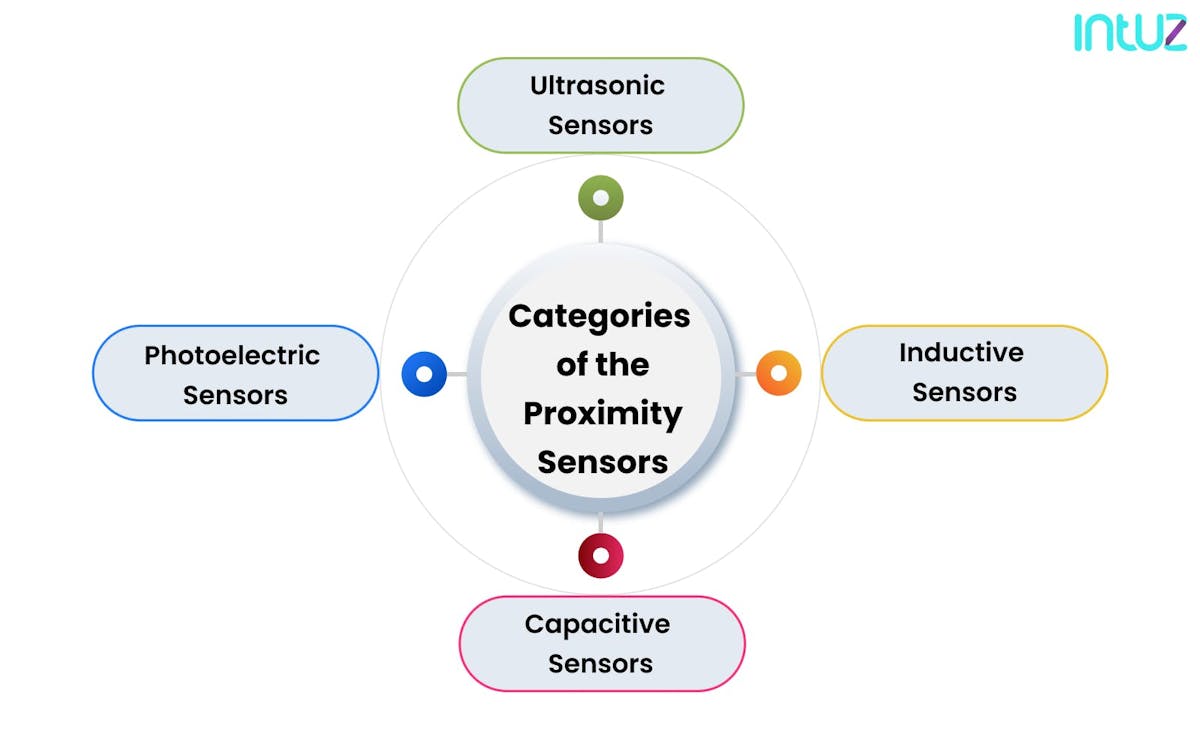
- Inductive sensors are robust and used for non-contact detection of the presence of metallic objects. Meaning, it applies electromagnetic field to do so. It can operate at a faster speed and is more reliable compared to mechanical switches.
- Ultrasonic sensors are ideal for detecting objects in harsh conditions as they do so by measuring the distance of targets similar to sonar or radar.
- Photoelectric sensors are composed of light-sensitive parts. They use a beam of light to detect the presence or absence of an object, and are ideal for long-distance detection of non-metallic objects. For instance, a Through-Beam sensor can see objects more than 10m away.
- Capacitive sensors can detect both metallic and non-metallic objects and are generally used in complicated applications. In simple words, they can pinpoint any object regardless of material.
Use cases
Proximity sensors are ideal for the retail industry because they can detect motion and correlation between the customer and the products they might be interested in.
They are considered to be more reliable than infrared sensors and are used in manufacturing and obstacle avoidance systems.
Mobile multi-touch displays, popularized by Apple’s iPhone, is the most common example of capacitive sensors.
3. Acoustic and noise sensors
Such sensors capture the noise levels emitted within the range of connected devices. Acoustic and noise sensors analyze the surrounding ambient sound using an integrated microphone. They allow you to keep track of the sound levels and generate reports based on the findings.
Features
- These connected devices are extensively used in construction, farming and manufacturing where noise levels can be particularly dangerous.
- They are used for monitoring road traffic and analysing noise pollution on the highways.
- Specific noise detectors help ensure the well-being of pets or kids inside homes.
Following are two sub-categories of acoustic and noise sensors:
- A hydrophone is an underwater device which identifies and records ocean sounds from all directions. What you may be surprised to know is that the underwater world is not silent. The majority of marine life uses sound for communication, hunt for prey and reproduction. A hydrophone can be deployed at a depth of more than 10,971 m. It can record deep-ocean ambient sound levels in a span of three weeks.
- A geophone is a device which converts ground movement into voltage and can be recorded at a recording station. It is used by seismologists and geophysicists to measure voltage from the baseline, which is regarded as seismic response. A geophone helps analyse the Earth’s structure better.
Use cases
They are used in consumer electronics such as music systems, burglar alarms, and phones. Noise sensors play an important role in home automation by detecting whistling or clapping to switch on or off the lights in the house.
4. Humidity sensors
These sensors are used to track the air’s relative humidity, or the percentage of water vapour and other gases present in the air.
Features:
- In high-temperature or corrosive environments, the thermal conductivity sensor is a durable option. This measures absolute humidity rather than relative humidity.
- Typically, humidity sensors come in-built with temperature sensors, which track how much heat energy there is at a source.
- When using humidity sensors, it is important to know what the density of the air is like at standard temperature and pressure so as to make accurate measurements.
There are two main types of humidity sensors, capacitive and resistive.
- Capacitive sensors feature two electrode layers with a dielectric material in between that can absorb moisture from the air.
- Resistive sensors measure relative humidity by tracking the change in resistivity between two electrodes with the help of a hygroscopic conductive layer.
Use cases
Humidity sensors are used often in factories to avoid condensation on the floor. The sensors enable real-time monitoring of the factory’s HVAC systems and thus allow for quick responses to changes in moisture levels.
They are also useful for detecting chemical changes in the air and thus preventing health hazards at industrial units. Humidity sensors also help weather stations with proper forecasting.
5. Image sensors
They are also known as “Optical Sensors.” These connected smart devices are embedded into systems to capture and convert images into a digital signal that can be transmitted over a network.
Features
- They are built using an array of photodetectors, known as pixels.
- These sensors respond to light and convert it into images which are further processed into electrical signals for analysis.
- Image sensors allows the connected IoT devices to see the environment where the sensor is installed.
- These sensors can be tailored to process images and use the data to make informed decisions by humans.
- The sensors consume low power yet generate high-quality still images or videos.
They are of two types of image sensors, which use different technologies but display similar quality results:
- Charge-coupled device (CCD)
- Complementary metal-oxide-semiconductor (CMOS)
Both CCD and CMOS image sensors use metal-oxide semiconductors.
Use cases
Image sensors are used in robots, drones, connected lighting, barcode scanners, and digital camera systems. These can then be used as tools for industrial monitoring, security surveillance, smart agriculture, and medical imaging purposes.
They are used in smart vehicles, night vision equipment, military equipment and radar, biometric devices in factories and offices. Sony Pregius offers the technology for industrial, utility, and aviation usage.
6. Pressure sensors
These are connected devices that measure the amount of force needed to stop a fluid (liquid or gaseous) from expanding. They are among the most popular IoT sensors for industrial applications.
Features
- For certain types of applications, like measuring levels in a tank or for measuring animal weight, load cells can be used as pressure sensors.
- These sensors detect the amount of pressure and then convert it into electrical signals. They then generate a switching output that operates at a specific pressure level or an analog output that is proportional to the pressure.
- Pressure sensors are easy to use — by connecting them to an IoT module, they can start generating data to appear on a computer screen.
There are two main types of pressure sensors:
- Gas pressure sensors are used mostly in the petrochemical and energy industries to monitor changes in gas pressure.
- Barometric sensors measure atmospheric pressure variations, and are a mainstay of weather stations.
Use cases
In countries everywhere, gas and energy infrastructure is highly reliant on these sensors to keep track of system pressure and take instant action to address any fluctuations. Pressure sensors are also used to check for any water leaks in residential or commercial buildings.
7. Magnetic sensors
Quite interestingly, they walk on the lines of proximity sensors. They detect the presence of objects by emitting electromagnetic radiation. Magnetic sensors detect changes in flux, strength, and direction of a magnetic field.
Features
- The sensors emit an electromagnetic field and react to changes in the field or return signal.
- These sensors measure mechanical displacement and motion.
- These are useful for contact-less detection of a magnetic field.
- They also can control the flow of electricity through them, and so can be used to trigger an action upon the presence of an unwanted object — whatever it may be.
- Magnetic sensors offer linear, angular, and rotation sensing.
There are three types of magnetic sensors:
- TMR (Tunneling Magneto-Resistive) sensors
- Reed switches
- Hall Effect sensors
Alternatively, based on application, proximity sensors are categorized as ultrasonic sensors, capacitive sensors, inductive sensors, and photoelectric sensors.
Use cases
Proximity sensors are used in retail stores, museums, parking spaces, airports, malls, industries, military and defense systems. They are used in autonomous vehicles, automated parking systems, security alarms, anti-theft systems, and position tracking systems.
Crocus has developed high-sensitivity, low-power consuming magnetic sensors. These have specific application-based design functions with endurance for high-temperature and high-frequency operation.
8. Motion sensors
These sensors detect movements within a certain radius of vicinity and thus send out alerts about the presence of someone or something.
Features
- Motion sensors detect physical movements and then convert them into electrical signals.
- You must have come across them in public spaces. These devices are extensively used in automated hand dryers, doorways, toilet flushes and soap dispensers, all of which are used widely in commercial buildings and hotels to conserve energy.
These sensors come in both ultrasonic and infrared varieties:
- Ultrasonic motion sensors give out ultrasonic waves that bounce off objects in the vicinity and return to the sensor, thus detecting the presence of the object and how close it is to the sensor.
- Infrared motion sensors detect fluctuations in the temperature in the immediate vicinity, thereby indicating the presence of a human, animal or object — all of which give off some amount of thermal energy as infrared radiation. Think hand dryers!
- There is also a third type of motion sensor that uses microwave pulses to detect the presence of objects. While a microwave motion sensor has a much larger area than the other two types of sensors, it is also much more susceptible to electronic interference.
Use cases
Motion sensors are popular in security applications. Homeowners and commercial buildings use them in camera triggers and gate monitoring systems to detect unusual activity that could signal the presence of an intruder.
9. Air quality sensors
They detect variations in the air quality due to the presence of chemicals, gases, and suspended particles. They are useful for the detection of toxic or combustible gases.
Features
- Traditionally, these sensors used Beta Attenuation Monitors (BAM) technology, which is being replaced by Tapered element oscillating microbalance (TOEM) as it offers significant advantages such as real-time detection of aerosol particles.
- These sensors gauge air purity consistently.
- Gas sensors Air Quality Index (AQI) is an important indicator of air quality and these sensors help maintain the air quality standards.
Air quality sensors are of two types:
- Gas sensors detect any changes in the composition of air due to leakage of gases such as Nitrogen Dioxide and Sulfur Dioxide and so on.
- Particle Matter sensors detect the presence of dust or other suspended particles (PM10 and PM2.5) in the air by measuring its opacity.
Use cases
Air quality sensors are used in industries for monitoring toxic or combustible gas, monitoring the air quality of a city, and during manufacturing of rubber, plastics, and paint.
They also help in avoiding accidents by detecting hazardous gas in coal mines, chemical laboratory research, oil and gas, and pharmaceutical industries.
Ambient Weather offers an outdoor particulate matter monitor for home and office use. It alerts for rising levels of pollutants in the area.
10. Accelerometers
Such sensors are used to capture the non-gravitational acceleration of an object, which in turn enables the measurement of its inclination and vibration. An accelerometer is a compact device that measures vibrations in the object it is integrated with.
Features
- When the object moves from rest to velocity, the accelerometer responds to the vibrations induced by that movement.
- Accelerometers contain capacitive plates, some fixed and others attached to springs. As the object moves, these plates start moving in relation to one another, leading to changes in capacitance from which changes in acceleration can be measured.
- Accelerometers are usually low-power devices, making them ideal for battery-powered applications.
- Accelerometers are at the core of vibration sensors that convert acceleration data into vibration frequencies, thereby detecting any subnormal movements.
The main types of accelerometers used in Internet of things contexts include Hall Effect, capacitive and piezoelectric accelerometers.
Use cases
Accelerometers are frequently used in industrial contexts, where they measure whether machines are operating properly by tracking their vibrations.
11. Water quality sensors
These instruments are useful in maintaining the purity of water. They measure it based on parameters such as conductivity, levels of dissolved oxygen, pH, temperature, turbidity, and salinity. These sensors help conserve the environment and maintain public health.
Features
- Water quality is evaluated on these parameters to ensure its fitness for individual consumption and industrial usage.
- Water quality sensors analyze the chemical, biological and physical condition of the water so that appropriate decisions can be taken to preserve its purity.
- These devices can measure the purity of stored water in boilers and even in water bodies such as lakes, rivers, and ponds.
- These sensors may be submersible or floating type.
There are three types of water quality sensors based on their applications:
- pH sensors monitor water quality by calculating and comparing its alkalinity.
- Turbidity sensors estimate the suspended solids in water by calculating the amount of light scattered by them. More light passes through the clear water and less through turbid water.
- ORP (Oxidation-Reduction Potential) sensors are used for ion monitoring. They measure the ability of water to act as an oxidizing or reducing agent.
Use cases
Water quality sensors are used in swimming pools and overhead tanks (Chlorine Residual Sensors).
They are also used for large-scale quality gauging of rivers and streams, wastewater, and effluent measurement in water (Turbidity Sensors). Vernier provides ORP sensors to control water quality in swimming pools.
12. Gyroscopes
Gyroscope sensors are used to capture data about an object’s orientation in three-dimensional space. They are also known as angular velocity sensors or angular rate sensors. The principle of a gyroscope is using Earth’s gravity to track the angular motion of an object.
Therefore, to build a gyroscope, a freely-rotating disk (known as a rotor) is mounted on a spinning axis at the centre of a more stable wheel. As the axis spins, the rotor remains still, thus indicating which way is down.
Features
- Gyroscopes can calculate the speed or angular velocity of the object in real-time, and are thus a crucial component of most smart navigation systems.
- These instruments are integrated into most accelerometer chips as a compact package, which enables more accurate motion sensing in electronic devices.
- There are three types of angular rate measurements that a gyroscope can pick up — yaw (horizontal rotation when seeing an object from above), roll (horizontal rotation when seeing the object from the front) and pitch (vertical rotation when seeing the object from the front).
Types of gyroscopes include rotary, vibrating structure, optical and micro-electro-mechanical systems (MEMS) gyroscopes.
Use cases
Gyroscope sensors are essential to modern automotive systems. Not only do they facilitate better car navigation, but they can also detect skidding and respond with automated braking.
They are also popular in mobile game design, and allow the phone to detect whether the game is in portrait or landscape mode (and thereby how best to play the game).
13. Level sensors
Such devices are used to measure the level of a liquid or any other substance in an open or closed system. They help businesses monitor, measure, and maintain levels of items in storage or transit systems.
Features:
- Level sensors help in measuring the levels of a substance.
- They keep a check on transit accidents due to overflow.
- Not so surprisingly, these sensors are also useful for maintaining stocks of liquids.
- Level sensors can also be classified as invasive and non-contact sensors.
- Invasive sensors remain in direct contact with the substance, while non-contact sensors measure substances using sound or microwaves.
There are two types of level sensors based on their usage. These are:
- Point level sensors indicate the presence of a liquid at a designated point in its storage container.
- Continuous level sensors measure the exact level of a liquid available in a storage container.
These are the common types of level sensors used in various industries:
- Float switch
- Capacitance sensors
- Optical sensors
- Conductive sensors
- Tuning fork
- Ultrasonic devices
- Radar
Use cases
Level sensors are mostly used for fuel gauging in large vehicles, sea-level monitoring to calculate tide levels, and issue Tsunami warnings. They are also used in water reservoirs, medical equipment, hydraulic reservoirs, beverages, and pharmaceutical processing.
Sierra Instruments produces industrial-grade level sensors to help companies maintain optimum levels of their liquids and gases.
14. Flow and gas sensors
Gas sensors are used often in the manufacturing, health and oil and gas industries to detect the concentration of different gases in the air, including greenhouse gases and toxins. They are similar to flow sensors, which detect the flow rate of a moving fluid (liquid or gas).
Features
- While gas sensors were traditionally clunky devices, recent advancements have led to low-power versions that can be used for local applications, such as breathalyzers or carbon monoxide detectors.
- When connected to smart meters, gas sensors can measure gas concentrations remotely. If gas leaks are detected, the gas sensor can send an instant alert to the remote control system to initiate a shut-down.
- Flow sensors, on the other hand, work by measuring the cooling effect of a gas as it travels over a heated wire, after being suitably programmed with information about the gas density.
- Flow sensors help in establishing control over liquid flow rate and dispensing, where even small changes make a big difference to wherever they are being implemented.
Use cases
Manufacturing units install gas sensors to monitor indoor air quality and detect the presence of anything toxic or combustible, thus enabling better workplace safety.
These sensors can also be integrated into building HVAC systems to improve air quality and ensure better comfort for the building’s occupants. Flow sensors are used often in medical applications, such as oxygen dispensers.
15. Chemical sensors
They are used to detect changes in the chemical composition of liquids and gases. Chemical sensors are widely used to control the pollution in components and avoid accidents.
Features:
- As the name suggests, these devices detect chemical contamination.
- They help track changes in the chemical composition of a substance.
- These sensors convert the physical properties of a substance to measurable digital signals.
Commonly used chemical sensors are Chemical field-effect transistor, Chemiresistor, Electrochemical gas sensor, fluorescent chloride sensor, Hydrogen sulfide sensor, Nondispersive infrared sensor, pH glass electrode, Potentiometric sensor, and Zinc oxide nanorod sensor.
Use cases
Chemical sensors are used in process control across a wide array of industries like pharma, automotive, home, and office alarm systems. They help keep a check on the accidental release of harmful chemicals in manufacturing units, laboratories, and factories.
These even detect explosive and radioactive materials and can be used for recycling processes on Space Station, pharma industries and laboratories, and so on. Atonarp is a leading manufacturer of Chemical IoT sensors to maintain the purity of substances.
16. Infrared sensors
Infrared sensors are a cost-effective alternative to motion sensors. All objects give off some amount of thermal radiation, which is what these sensors can detect and react to.
Features
- Infrared sensors detect the energy given off by an object, such as a machine or a nearby person. They then transmit a wave to an electronic circuit to measure the temperature.
- Depending on the intensity of the energy signal received, the output of the infrared sensor will vary.
Infrared sensors are of two types, active and passive:
- Active infrared sensors use infrared detectors like photodiodes to detect an object.
- Passive infrared sensors are of two subtypes, thermal and quantum, of which quantum sensors are much faster.
Use cases
Infrared sensors have multiple security applications, from alerting the police about any suspicious activity to turning lights on when someone comes within a certain radius of the light to detecting chemical leaks in an industrial plant.
They also have medical applications wherein they track the pressure and blood flow in a patient or monitor fitness levels through inclusion in a smartwatch.
17. Rain sensors
These devices are useful for detecting rain. They use an infrared (IR) transmitter unit to receive and reflect the light of varying intensity. These sensors may be used as stand-alone solutions or in a network.
Features
- Rain sensors indicate rainfall levels to initiate a reflex or corrective measure.
- These sensors work like switches that get switched on automatically upon coming in contact with water.
- Rain sensors work as a resistive dipole. They show high resistance when the weather is dry and lower when it is wet.
- These instruments are easy to install and cost-efficient.
- They help conserve water and avoid watering systems.
The common types of rain sensors are:
- Water collection basins
- Conductive sensors
- Hygroscopic disk
- Freeze sensors
Use cases
Rain Sensors are used in irrigation systems and water sprinkler systems in the agricultural industry. They measure the rainfall and regulate water flow through automated systems to maintain plant health. Rain sensors control overwatering and reduce operational costs.
These sensors are also installed in cars to automatically activate wipers to help avoid accidents. D+H Mechatronic manufactures compact design rain monitoring systems enabled by rain sensors for the automatic reinforcements of wipers.
Rain sensors are also used in specialized satellite communication aerials. The sensors activate a rain blower over the opening of the aerial feed that helps in keeping the mylar wrap dry.
18. Optical sensors
These include both electro-optical and light sensors. They are environment sensors that capture a certain amount of light and then turn it into a digital signal.
Features
- Optical sensors are used largely for measuring electromagnetic energy, from the infrared level all the way up to the ultraviolet level.
- They can detect various properties of light including frequency, wavelength, intensity and polarisation.
- The photodiode is commonly used in light sensors. It can convert light into an electric current and thus detect the exact level of light intensity.
- They can detect water levels by tracking the refraction of light in a prism after bouncing off the surface of the water.
Types of optical sensors include fibre optics, pyrometers, photodetectors and proximity sensors.
Use cases
Optical sensors are used in the automobile industry for functions like light detection, object recognition and smart parking. They are also used in the urban infrastructure of smart cities for facial recognition, traffic monitoring and adaptive street lighting.
19. Smoke sensors
These are electronic fire-protection devices that indicate the presence of smoke or any airborne particles in the air.
Features
- Optical smoke sensors detect the presence of smoke in a chamber and provide an output such as raising an alarm.
- An Ionization alarm works on radioactive material. A small amount of the radioactive substance is placed between two electrically charged plates. It detects the smaller particles of smoke as well.
There are two types of smoke sensors:
- An optical sensor is also known as a photoelectric smoke detector. It gauges the scattering of light due to the presence of smoke.
- Ionization sensor is more sensitive to larger flames of fire while the photoelectric sensor detects even smoldering fire.
- Aspirating Smoke Detectors (ASD) are among the most advanced and highly sensitive smoke sensors available in the market.
Use cases
Optical smoke sensors are installed in almost all factories, offices, and multistoried residential buildings. They secure these facilities from accidental fires through early and accurate detection of smoke.
Credencys manufactures smart IoT-powered smoke sensors that can be accessed through a mobile device. These detectors also send push notifications on the connected device to alert the user in case of a fire.
20. Light sensors
These are photoelectric sensors that convert light energy (photons) into electrical energy. They have several applications in security and brightness control, including ambient light settings on mobile phones and laptops.
Features
- A light sensor operates by measuring the quantity of light and then converting that into electrical energy, which can be read by an IoT instrument.
- In many cases, light sensors are a cheaper alternative to motion sensors, as they can detect physical presence in an elevator or a hallway and turn the lights on accordingly.
There are two popular types of light sensor:
- A photoresistor is made of a semiconductor material known as cadmium sulfide and works through changes in resistance by radiation, and can be used as an analog light sensor rather effectively and reliably.
- A photodiode, on the other hand, works on the inner photoelectric effect. Photons are absorbed and then an electron is transferred to the conductivity band, resulting in an electron-hole pair. When an amplifier is added to the photodiode, it is known as a phototransistor and enables better light sensitivity.
Use cases
Light sensors are a valuable part of agriculture, where they help to measure the amount of light absorbed by the soil and thus how quickly plants can grow in that soil.
They are also used in commercial contexts to determine how bright the internal lighting needs to be in relation to natural light outside.
21. LDR sensors or Light Dependent Resistors
Also known as photoresistors, these instruments work by detecting the intensity of light. These sensors work on the principle of photoconductivity.
According to this principle conductivity of a material is increased upon absorbing light. The resistance of LDR is high under low light conditions and vice versa.
Features
- LDR sensors respond to light falling on them and give an output like raising an alarm or taking an action.
- They are made of a semiconductor photosensitive material.
- The sensor is triggered when the light intensity around the sensor crosses the threshold value.
- These light-sensitive resistors are made of Cadmium Sulfide (CdS) cells.
LDR sensors are of two types:
- Intrinsic Photo Resistors
- Extrinsic Photo Resistors
Use cases
LDR Sensors are commonly used in automating street lighting by detecting day or night, ambient lighting, automatic Headlight Dimmers, position sensors, and Automatic Rearview mirrors of automobiles.
Installing these sensors helps in saving energy and costs compared to the manual operation of floodlights along a highway. They are being widely used in smart city concepts to eliminate the need for manually controlling street lamps.
Potential Labs offers IoT-based LDR sensors that can be connected to a computer system for easier control.
22. Alcohol sensors
As the name suggests, these devices are useful in gauging alcohol or ethanol content in the air. They are used commonly in breathalyzers to estimate the molecular content of alcohol in the breath of an individual.
Features:
- Alcohol Sensors detect alcohol content and convert it to estimate alcohol concentration in a substance e.g. blood.
- Alcohol sensors are mainly used to estimate blood alcohol concentration (BAC). These sensors are useful in controlling road accidents due to drunken driving.
These alcohol sensors are of three types:
- Conventional breathalyzers constitute Potassium Dichromate, Sulfuric acid, and Silver Nitrate. The oxidation and reduction of these compounds in the presence of Ethanol help the sensor deduce the presence or absence of alcohol.
- Intoxilyzers are more accurate than breathalyzers. They use infrared radiation (IR) to measure the deflection of wavelengths upon reacting with alcohol molecules.
- Alco-Sensors are the most advanced Alcohol Sensors. These are also known as Fuel-Cell Alcohol Sensors.
Use cases
They are useful to detect alcohol consumption by employees or workers at factories, mines, and other hazardous tasks.
Senseair has developed an “Automatic Engine Locking System '' using Alco-Sensors. The system is contact-free and has the ability to measure alcohol content in the driver’s blood. It all happens while the driver is seated comfortably and breathing normally.
Streamline operations with Industrial IoT. Contact us!
Explore NowThe future of IoT sensors is bright
One thing is for sure — sensors are deeply rooted in our daily lives and business situations. Even the most basic things like reversing a car uses some form of a sensor. As mentioned previously, IoT sensors are already being used extensively in various fields to respond to social needs.
Using technology that does not require human assistance definitely makes sensors an important part of our future workstyle reforms.
And with the rise of the Internet of things in practically everything we do, the sensors will only gain precedence in terms of production and availability in the many years to come.
